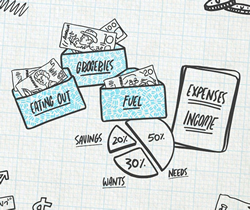Jessica Sier* says this budget gives people parameters to operate in and certainty about where thier money is going.
 In this post, we assume that you’re budgeting with your after-tax income, that is, the money left over once you’ve paid super and tax.
In this post, we assume that you’re budgeting with your after-tax income, that is, the money left over once you’ve paid super and tax.
The 50/30/20 budget is where you split up your income into:
- 50 per cent needs (groceries, rent, utilities, health insurance, repayments);
- 30 per cent wants (shopping, dining out, hobbies); and
- 20 per cent savings.
This method is an easy way of managing your money.
It gives you parameters to operate in and certainty about where your money is going.
For example:
If you earn $1,500 a fortnight, every time you get paid you split your income out like this:
- $750 covers your rent/food/bills for the fortnight;
- $450 allows you to go out and enjoy yourself; and
- $300 is put away in savings.
Here is a percentage calculator if you’re not crazy about maths.
How to set up.
Thinking about money all the time can be incredibly dull, so it may be easier to automate this system.
Most online banks have a functionality to set up automatic payments which can help split your pay into different accounts for different purposes.
If in doubt, stroll on into your local bank branch and ask them to help.
You may consider setting up two extra bank accounts (in addition to the one you get paid into).
Before doing this, make sure you check whether there are any additional fees and costs for having separate accounts.
Do the maths on what your 50/30/20 split will look like, and then decide whether it’s suitable to set up automatic transfers for the day after you get paid.
Then you could direct the money into your other bank accounts.
Tip: Most banks allow you to hide accounts from your banking screen.
If you hide your savings account, you may be less tempted to use that money.
You’ll be surprised at how quickly money builds up when you’re not thinking about it!
Like everything in life, practice makes perfect.
It might take a few pay cycles (weekly, fortnightly, monthly) to get into the swing of things, but the 50/30/20 budget is a powerful way to build up money and stay out of debtonce you get the hang of it.
Remember:
- 50 per cent needs (such as groceries, rent, utilities, health insurance, repayments);
- 30 per cent wants (such as shopping, dining out, hobbies); and
- 20 per cent savings.
50 per cent: Your needs
Deciding between needs and wants is up to you, but it’s important to remember that the purpose of a budget is to help you.
So if you’re mixing up your needs and wants just so you can have another beer at the cricket, remember you could be chipping away at your overall financial wellbeing.
It’s unlikely anybody else cares very much.
Needs are basically any payment that would severely impact your quality of life, such as rent, electricity, prescription medicines, that kind of stuff.
Note: Somewhere to start may be to pay off debt or your credit card.
Depending on how you feel about debt, this is generally considered a need, because if you don’t pay it off you might end up paying lots of interest and developing a bad credit rating, which can really impact your financial goals.
Using this budget, you might pay your credit card minimum from your needs bucket and any extra amount you choose to pay on top of that from your 20 per cent debt and savings bucket.
Here’s an example.
If your minimum credit card payment required is $25 and you want to pay $100 that month to keep the balance under control, that additional $75 comes instead from your 20 per cent stream (see below).
30 per cent: Your wants
Yes fantastic.
Prada. Weekend trip to Tokyo. Weekly manicures. Italian restaurants.
Maybe.
But rather than extravagances, the ‘wants’ section is mostly about covering the basic niceties of life you enjoy.
These are things like new clothes, hair cuts and sure, maybe your Xbox Live subscription.
Sure, if you’ve got enough to cover a weekend jaunt to Tokyo, then why not.
But we believe that the power of the 50/30/20 budget is it puts into sharp focus what you can and can’t afford.
When your money is all lumped together, it may be easy to think we can afford way more things than in reality.
That’s when we may get into trouble.
Note: You might spend more on “wants” than you think.
We find that this is the trickiest section to adjust to.
20 per cent: Your savings and debt
If credit card debt is stressing you out, it’s worth considering paying it down as quickly as possible and developing habits that may mean you can happily live without owing money to your credit provider.
As such, if you begin directing 20 per cent of each pay cheque to a savings account we think its good practice to consider using it to pay off any past debt.
Credit card payments, car repayments, personal loans, loans from friends and family, library fines, car fines, student loans (that aren’t HELP).
These are all debts that can make it difficult for you to build wealth over time, because many of them carry interest chargers.
Interest is the money you pay for the convenience of borrowing that money in the first place.
And over time it can really add up.
So once you get rolling on your 50/30/20 budget, you could consider how the 20 per cent section could cover off debts before beginning savings program.
Because you’ll have slogged out that debt, you may be amazed at how quickly that savings balance can grow.
And you could find that this kind of backstop is an incredibly powerful motivator and mentally helpful tool to have as you grow and your circumstances change.
Once you’re in control of your debt, you can start to think about how investing might work for you, too.
Give it a go
It doesn’t take much time to set up the 50/30/20 budget and the sooner you start it, the soon you can start seeing how your behaviour might change.
Being financially competent is remarkably sexy.
And you never know, Prada, Tokyo and Italian dinners might be more attainable than you think.
*Jessica Sier is a financial journalist. Prior to that she led content at Spaceship and was a reporter at the AFR where she discovered that breaking down financial jargon was a public good.
This article first appeared at spaceship.com.au.










